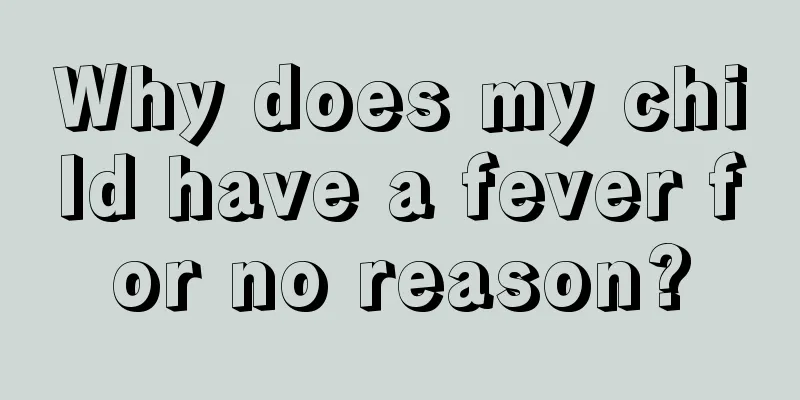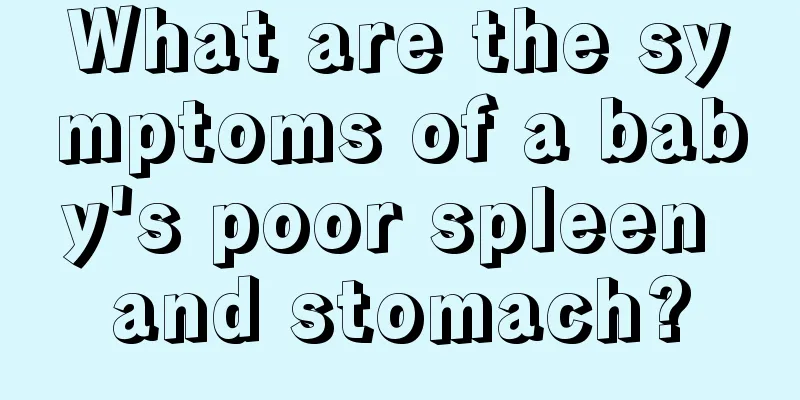Why does my child have a fever for no reason?

|
I wonder if mothers have ever had this experience: the child has a fever for no reason, without any warning or symptoms, as if the fever happened overnight, and it is a persistent high fever that lasts for a long time. What exactly causes the child to have a fever for no reason? If it is a cold, why are there no warning signs of a cold? What other reasons may cause a child to have a fever? Let's find out now! I hope everyone will always pay attention to their physical condition and never take things for granted. 1. Definition of fever Fever is a rise in regulated body temperature (more than 0.5°C) caused by the action of pyrogens which shifts the body temperature set point upward. Each person's normal body temperature is slightly different and is affected by many factors (time, season, environment, menstruation, etc.). Therefore, to determine whether you have a fever, it is best to compare your body temperature with your usual body temperature under the same conditions. If you do not know your original body temperature, an axillary temperature (tested for 10 minutes) exceeding 37.4℃ can be considered a fever. 2. Causes of Fever The body temperature is higher than normal, or there is a feeling of heat and discomfort. The causes of fever are divided into two categories: external and internal. Exogenous fever is caused by the six evil pathogens and epidemic qi; internal fever is mostly caused by diet, fatigue, or changes in the seven emotions, which lead to imbalance of yin and yang and deficiency of qi and blood. Exogenous fever is mostly real, and is seen in colds, typhoid fever, febrile diseases, plague and other diseases; internal injuries are mostly virtual, and include yin deficiency fever, yang deficiency fever, blood deficiency fever, qi deficiency fever, asthenia fever, yang floating fever, and blood loss fever. Fever types include high fever, low fever, aversion to heat, fever and chills, alternating chills and fever, hot flashes, fever in the five parts of the body, and sudden fever. According to the time of fever, there are dawn fever, daytime fever, evening fever, night fever, etc. According to the location of the fever, there are muscle heat, pores heat, shoulder heat, back heat, elbow heat, radial skin heat, palm heat, back of hand heat, foot heat, limb heat, etc. There are also fever caused by blood stasis, fever caused by food accumulation, fever caused by drinking, fever caused by blood stasis, and fever after illness. 3. Treatment of fever Cold compress. If you cannot tolerate a high fever, you can use cold compress to help lower your body temperature: place a wet cold towel on your forehead, wrists, and calves. Other parts of your body should be covered with clothing. When the cold compress reaches body temperature, it should be changed. Repeat this process until the fever subsides. You can also wrap ice cubes in a cloth bag and place it on your forehead. Hot compress: If the body temperature is not too high, you can use hot compress to reduce fever. Use a hot, wet towel to repeatedly wipe the patient's forehead and limbs to dissipate heat from the body until the fever subsides. However, if the body temperature rises above 39°C, do not use hot compresses to reduce the fever. Use cold compresses to prevent the body temperature from continuing to rise. Wiping the body and evaporation also have a cooling effect. Experts recommend using cold tap water to help the skin dissipate excess heat. Although you can wipe (with a sponge) the whole body, you should pay special attention to some parts with higher body temperatures, such as the armpits and groin. Squeeze out excess water from the sponge and wipe one part at a time. Cover the rest with clothing so that the body temperature can evaporate the water and help dissipate the heat. Take a bath. Sometimes a warm bath is the most comfortable thing. It can also relieve fever symptoms and replenish fluids. When you have a high fever, your body will sweat to dissipate heat; but when you have a high fever, your body will lose too much water and close the sweat glands to prevent further water loss, which makes your body unable to dissipate heat. The solution is to replenish fluids by drinking plenty of boiled water and fruit and vegetable juice. Fruit and vegetable juices are rich in vitamins and minerals, especially beet juice and carrot juice. If you want to drink tomato juice, choose a low-sodium product, and avoid solid foods during the fever until the condition improves. IV. Precautions If you feel very hot, take off too much clothing so that the heat in your body can be released. However, if you shiver as a result, it means that you are wearing too little clothing and should add more until you are no longer cold. At the same time, do not make the room temperature too high. Doctors usually recommend that it should not exceed ℃. At the same time, the room should be properly ventilated to help recovery and keep soft light to relax the patient. The above is all about children having fever without reason. If a child has this condition, you must take the child to the hospital for examination and treatment in time. Whether it is caused by non-infectious reasons or infectious diseases, you need to go to the hospital to clarify the cause. Only in this way can you know how to treat it. If the treatment is not timely, it may delay the disease and increase the difficulty of treatment. |
<<: What should I do if my baby has blue eyes?
>>: What is the cause of cold hands when the child has a fever?
Recommend
The baby suddenly can't walk, experts tell you why
Under normal circumstances, once a child starts t...
What should children eat to grow taller and fatter?
With the improvement of living standards, many pa...
Why does my baby love to sleep on his stomach?
Some of the baby's daily habits reflect the b...
What is the thing that prevents hunchback?
Hunchback is a phenomenon of spinal curvature tha...
What should I do if my one-year-old child has phlegm in his throat?
We have all experienced phlegm in our throats. Ge...
What to do if your baby has a cold and stomachache
We will add or remove some clothes as the seasons...
What are the benefits of circumcision for little boys?
As people in modern society pay more and more att...
What's wrong with a two-year-old child who can't speak?
If a child still can't speak by the age of tw...
What to do if your child coughs in the middle of the night
Summer has arrived, the weather has become very h...
Chicken wings recipe suitable for children
Children prefer to eat chicken wings, mainly beca...
Causes of stomach pain in five-year-old baby
If the child has a little bit of discomfort, pare...
12-year-old baby education
In life, many parents feel particularly worried a...
What should I do if my 16-month-old child has a fever?
Newborn babies have poor resistance and are weak,...
What is the disease of children's abdominal twitching?
If your child's stomach twitches involuntaril...
How to treat a foreign body sensation in a child's throat
When your child feels there is a foreign object i...









